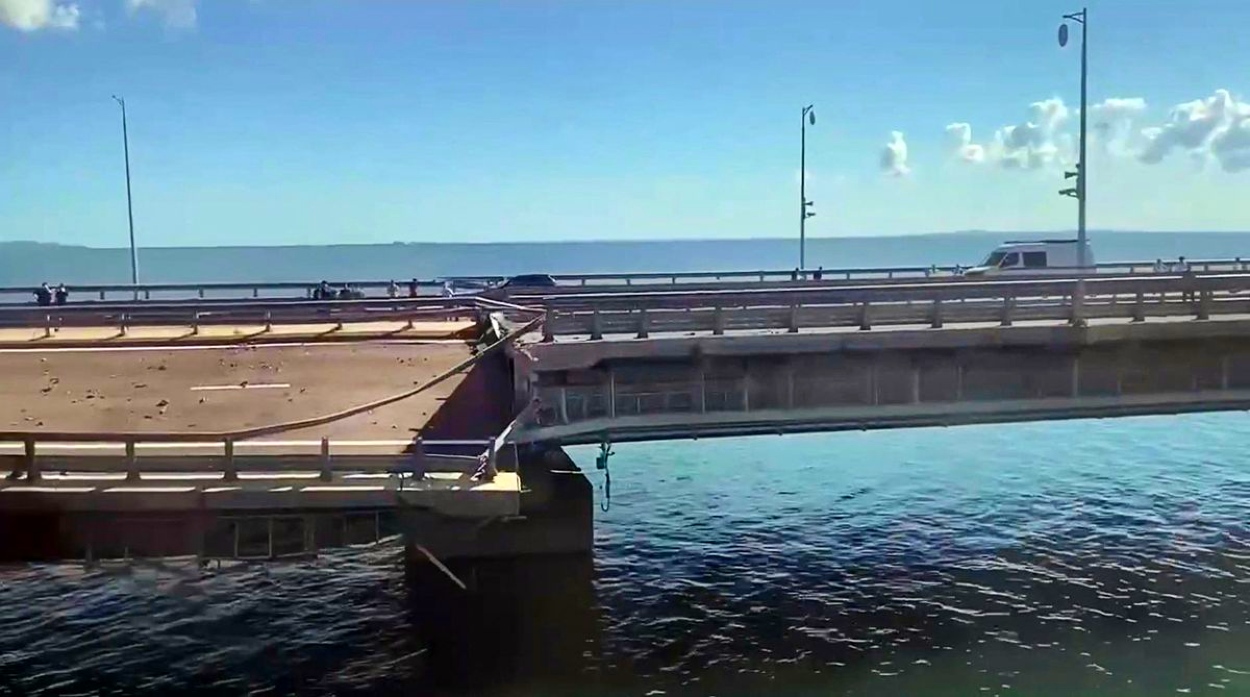Early on August 4, Ukraine launched coordinated aerial and maritime drone attacks on the Russian port of Novorossiysk and an oil storage facility in Fedosia.
As a result of the maritime drone attack on Novorossiysk, a Russian warship was damaged. However, the airborne drone attack on Fedosia failed to inflict any damage.
Attack On Novorossiysk
Ukraine released footage of one of its USVs closing into the Russian Navy’s large landing ship Olenegorsky Gornyak. Following the attack, video footage of the landing ship, listing to the port, and being towed into the harbor was posted on Telegram.
According to the RuMoD, Ukraine attacked the naval base in Novorossiysk with two Unmanned Surface Vessels (USVs).
“In the course of repelling the attack, the unmanned boats were detected and destroyed by fire from the standard weapons of Russian ships guarding the outer harbor of the naval base.”
According to some social media reports, a USV hit the port side of the large landing ship. As a result, one of the compartments was flooded, but the ship remained afloat.
BREAKING:
The Russian Ropucha-class landing ship Olenegorskiy Gornyak was heavily damaged in the Ukrainian drone attack against the port of Novorossiysk a few hours ago.
Largest loss suffered by the Russian Navy since the sinking of the Moskva! pic.twitter.com/Tt5OqgkgaU
— Visegrád 24 (@visegrad24) August 4, 2023
Since it was possible for tugs to tow the warship back to the safety of the harbor, the attacking USV likely exploded in close proximity to the Russian warship after it was destroyed by defensive cannon fire. A full-on impact would have likely resulted in the sinking of the ship, assuming that the drone was carrying an explosive payload exceeding payload of 450 kg, as reported by Reuters.
The fact that the Ukrainian video footage from the drone stops at a distance from the ship appears to corroborate the assumption that the USV was destroyed before impact.
Coordinated Aerial Drone Attack
The USV attack on the Novorossiysk harbor was coordinated with a massive aerial drone attack on Feodosia and the deployment of several US/NATO airborne ISR assets – RQ-4D Phoenix, two MQ-9A Reapers, and one R-8A.
According to Rybar, the USVs likely left the mouth of the Danube River on the afternoon of August 3. The SATCOM-equipped USVs were guided eastwards using a laptop-based control application from its control base. A Ukrainian AR4 Tekever surveillance and reconnaissance drone ensured the USVs were routed clear of shipping.
Around midnight, Ukraine launched four groups of Mugin-5 PRO drones (at least 18 UAVs) toward Crimea, most likely from the Chernobaevka airfield in the vicinity of Kherson.
BREAKING:
Ukraine has attacked Russia’s biggest port in the northern Caucasus, Novorossiysk, with naval and aerial drones overnight.
The Black Sea is becoming smaller and smaller for Russia.pic.twitter.com/0rvLbio1qF
— Visegrád 24 (@visegrad24) August 4, 2023
According to Rybar, one of the groups routed through Kalanchak to Armyansk and Cape Tarkhankut and the other through Chaplinka and Chongar in the direction of Feodosia.
The RuMoD states, “Ten UAVs were destroyed by air defense facilities on duty. Three more enemy drones were suppressed by means of electronic warfare.”
“There were no casualties or damage as a result of the foiled terrorist attack.”
Fedosia has large oil storage facilities and a power plant. According to social media reports, one UAV fell near an oil storage facility. However, there was no damage.
US/NATO Assist Ukrainian Attacks On Crimea
The Russian Crimean peninsula has come under the intense scrutiny of US/NATO satellites over the past month. US Topaz constellation Synthetic Aperture Radar (SAR) satellites make repeated passes over Crimea to photograph and pinpoint targets. During the past month, 29 satellite passes over Crimea were recorded.

The satellite passes are in addition to the near 24/7 surveillance by US/NATO RQ-4 Global Hawk drones which perform wide-area surveillance over a large geographic area, collecting imagery and signals intelligence data.
The RQ-4 features sophisticated SAR systems with all-weather, day-and-night imaging capabilities through clouds and haze. The EO/IR sensors on the Global Hawk allow it to capture high-resolution imagery and track targets using visual and infrared sensors. The drone’s SIGINT payloads can intercept and analyze electronic emissions, such as communications and radar signals, from different sources on the ground.
RQ-4-based surveillance has one limitation – it cannot be done directly overhead the target area in Crimea. The drone must keep a safe distance from the peninsula to avoid being shot down. Slanted imaging has some limitations. Satellite-based imaging augments the accuracy of drone-based imaging.
There has been a definite uptick in the participation of US/NATO airborne and space-based ISR assets.
Conclusion
Russia is known to have the electronic warfare (EW) capability to counter satellite and drone-based SAR imaging through its Krashuka-4 systems. There is some evidence that Russia is now employing EW against drone-based reconnaissance. A recent incident occurred where US/NATO drones were forced to return to base squawking emergency codes on IFF.
Russia’s Persevet combat laser is capable of blinding optical imaging satellites such as the US KH-11 Crystal series satellites. The large number of satellite passes being made over Crimea would suggest that their operations are being disrupted.
EW is a cat-and-mouse game with a counter for every adversary counter. As such, Ukraine will occasionally frustrate Russian defenses through coordinated attacks. What should not be overlooked is that the damage caused by the Ukrainian attacks is relatively small compared to the damage inflicted on Ukraine every day by Russian drone and cruise missile attacks.
- Vijainder K Thakur is a retired IAF Jaguar pilot. He is also an author, software architect, entrepreneur, and military analyst. VIEWS PERSONAL
- Follow the author @vkthakur